
Chest of drawers with doors, Boston, Massachusetts, 1640–1670. White oak, red oak, chestnut, maple, black walnut, red cedar, cherry, cedrela, snakewood, rosewood, and lignum vitae with red oak, white oak, and white pine. H. 48 7/8", W. 45 3/4", D. 23 3/4". (Courtesy, Yale University Art Gallery, Mabel Brady Garvan Collection; photo, Gavin Ashworth.)
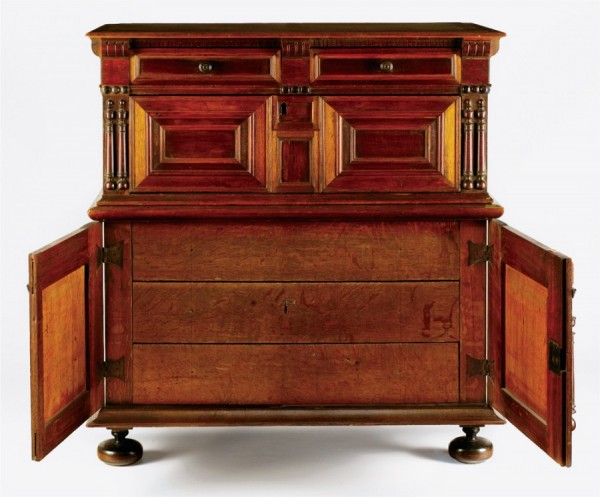
Detail of the chest of drawers with doors illustrated in fig. 1. (Photo, Gavin Ashworth.)
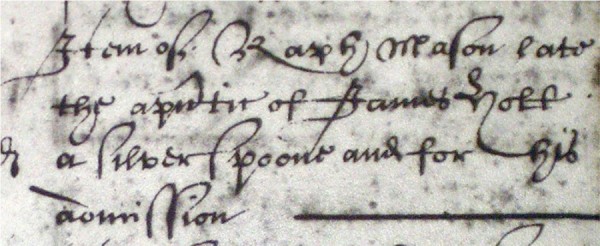
Admission record for Ralph Mason, Master’s and Warden’s Account Books, Worshipful Company of Joiners and Ceilers, London, 1621–1828. (Courtesy, Worshipful Company of Joiners and Ceilers, Surrey, England; photo, Peter Follansbee.)
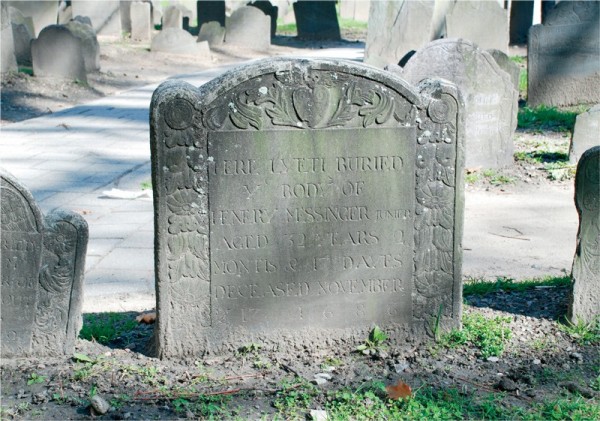
Gravestone of Henry Messinger Jr., Granary Burying Ground, Boston, Massachusetts, 1686. (Photo, Peter Follansbee.)
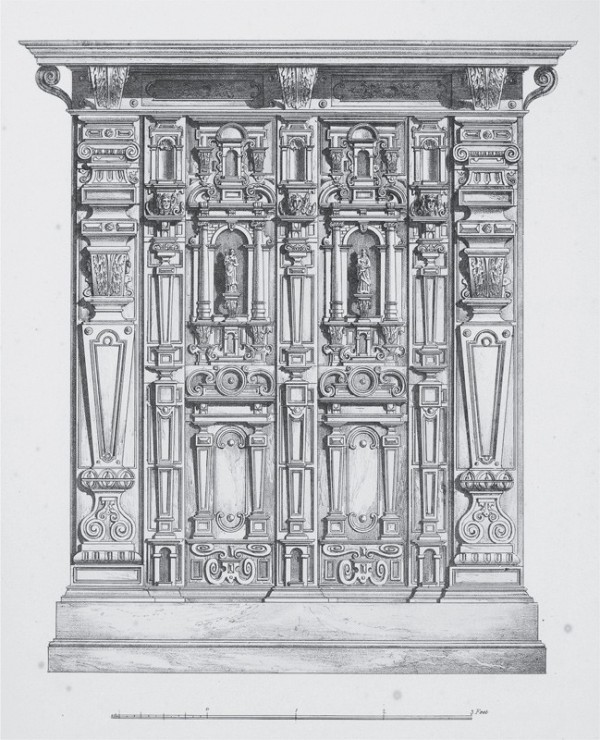
“An English Cabinet formerly the property of King Charles 1st at Theobalds,” from Charles James Richardson, Studies from Old English Mansions Their Furniture Gold & Silver Plate &c. by an Architect, 1st ser., 6 vols. (London: T. McLean, 1841–48), 1: pl. 19. (Courtesy, Winterthur Library, Printed Books and Periodicals Collection; photo, Jim Schneck.) The scale on the image indicates that the press is about five feet tall and probably was intended for books. The base appears to be a nineteenth-century addition. Originally there may have been a separate base or plinth.

Cabinet and chest of drawers, London, England, ca. 1628–1630. Woods not recorded. H. 59 1/2", W. 41 1/2", D. 16". (Courtesy, Edwin Willson and David Gill, Mary Bellis Antiques, Hungerford, Berkshire.)
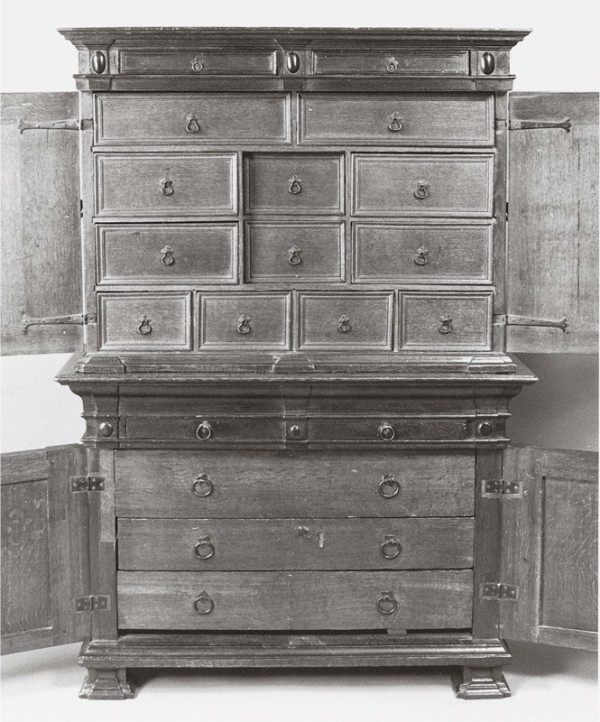
Interior view of the cabinet and chest of drawers illustrated in fig. 6. The upper section has a dovetailed board case, whereas the lower section has joined construction.
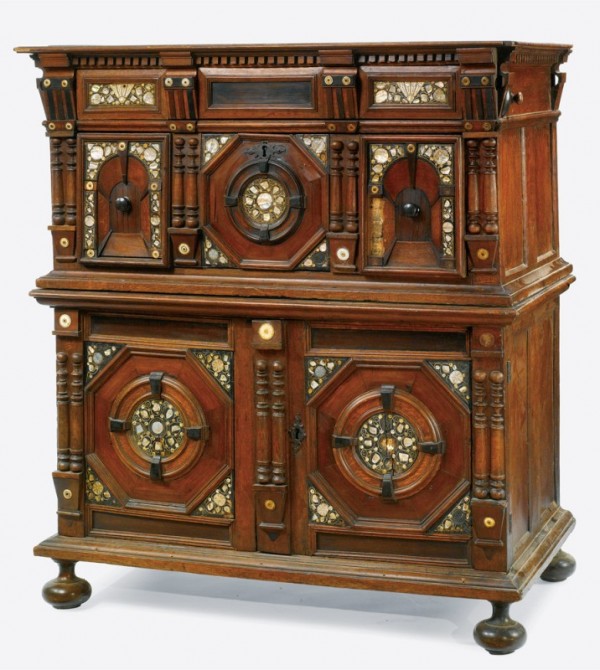
Chest of drawers with doors, London, England, 1650–1670. Oak, ebony, cocobolo (a pale tropical hardwood), mother-of-pearl, bone, and possibly ivory with unidentified secondary woods. H. 51 1/4", W. 46 1/2", D. 25 1/2". (Sotheby’s, A Celebration of the English Country House, New York, April 15, 2010, lot 43.) Several of the inlaid and ebonized oak plaques are missing, and the applied half-columns and feet are replacements.
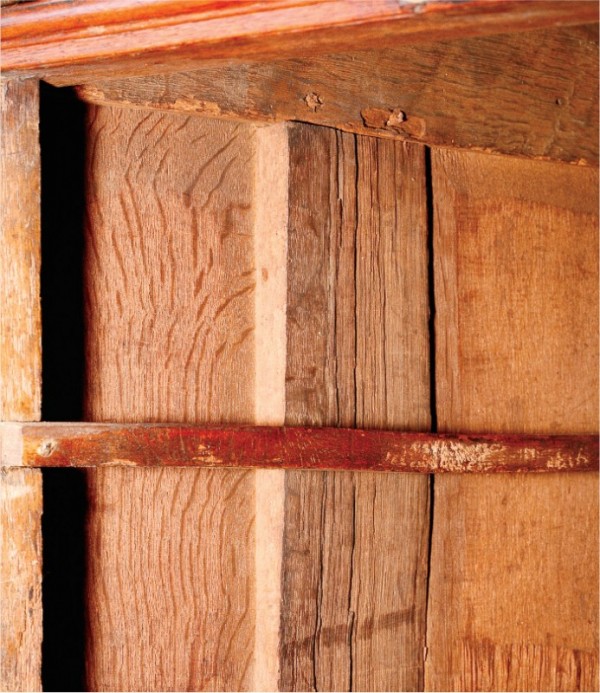
Detail of the chest of drawers with doors illustrated in fig. 8, showing evidence of riving on the interior of the upper case. Most of the framing members and some of the panels are made of riven lumber, while the drawer bottoms, rear panels, and the top of the upper case are made of sawn lumber.
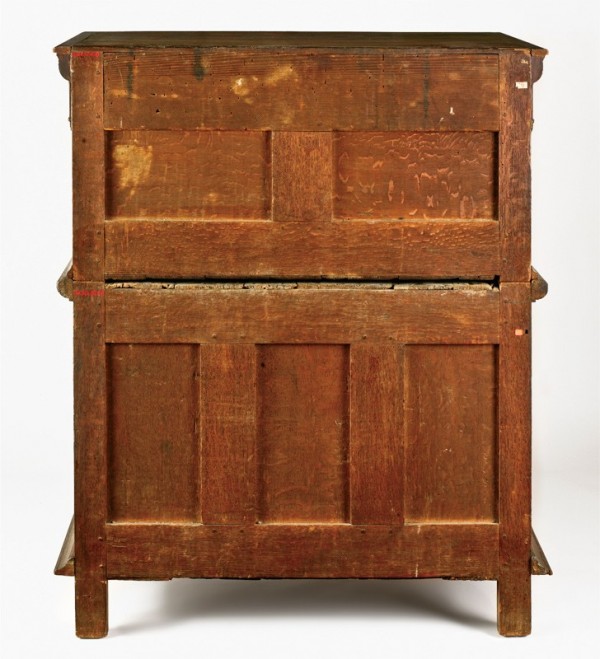
Rear view of the chest of drawers with doors illustrated in fig. 1. (Photo, Gavin Ashworth.)
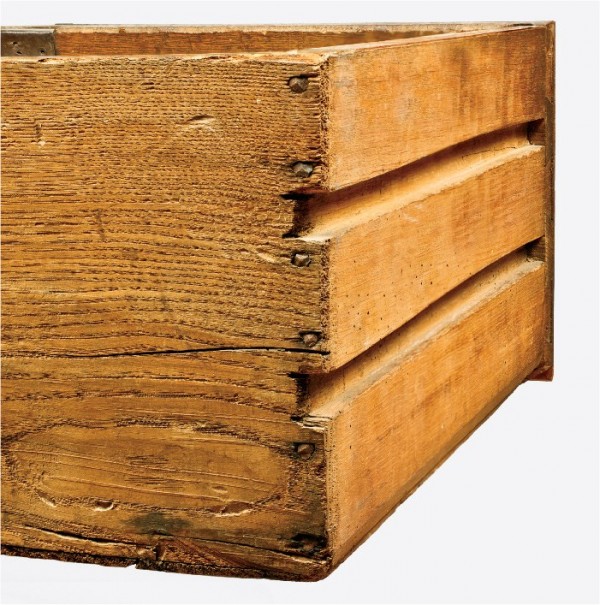
Detail showing the drawer construction of the chest of drawers with doors illustrated in fig. 1. (Photo, Gavin Ashworth.) The drawers are dovetailed at the front and nailed at the back.
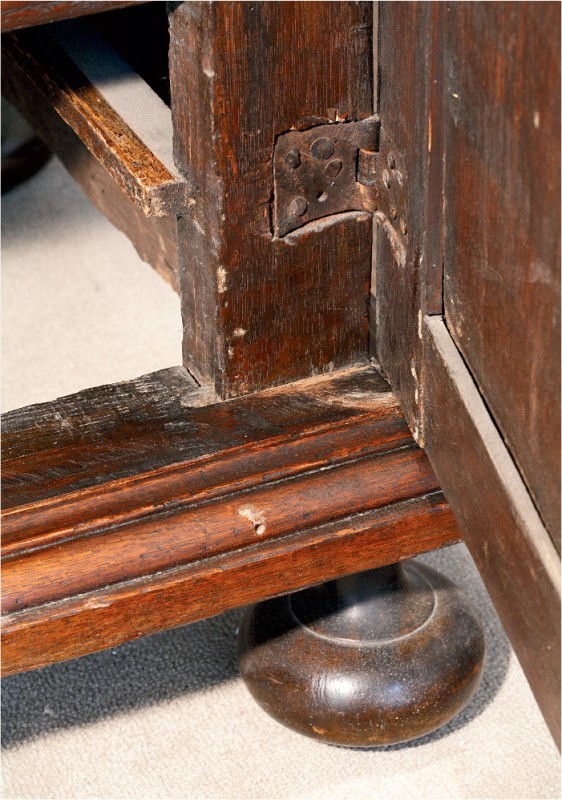
Detail of the chest of drawers with doors illustrated in fig. 8, showing the lipped tenon on one end of the lower front rail of the lower case. (Photo, Gavin Ashworth.)
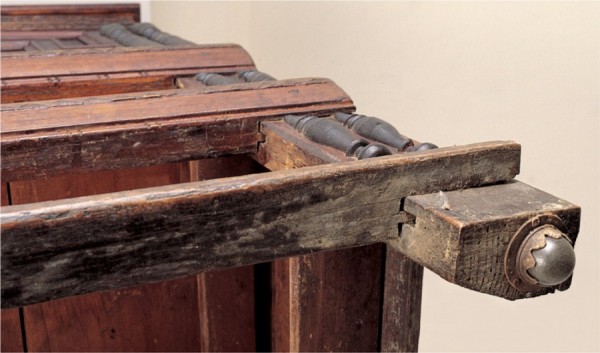
Detail of lipped tenons on a chest with two drawers, Plymouth Colony, Massachusetts, 1650–1690. (Courtesy, Plimoth Plantation, Plymouth, Massachusetts.)
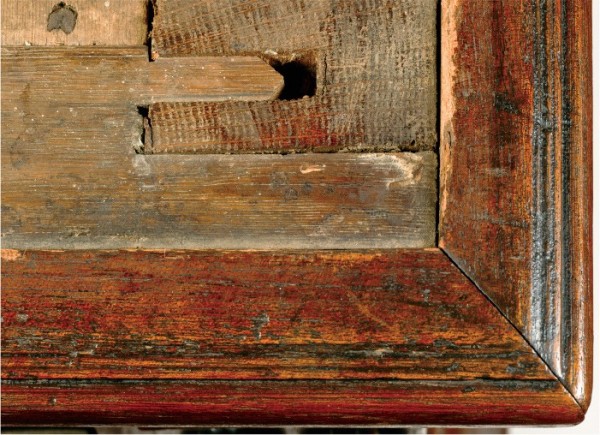
Detail of the chest of drawers with doors illustrated in fig. 1, showing the lipped tenon of the upper front rail of the lower case. (Photo, Gavin Ashworth.)

Armchair attributed to Kenelm Winslow, Plymouth, Massachusetts, 1640–1660. Red oak. H. 42", W. 24", D. 15". (Courtesy, Pilgrim Society, Pilgrim Hall Museum, gift of Abby Frothingham Winslow, 1882.)
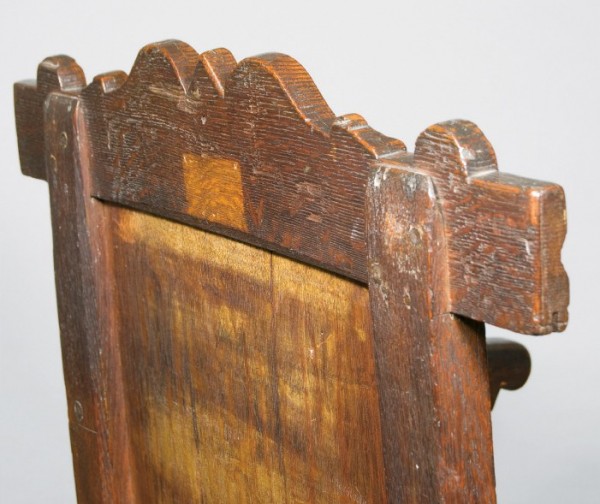
Detail of the back of the crest of the armchair illustrated in fig. 15. (Photo, Peter Follansbee.)

Chest of drawers 1640-70. Boston, Massachusetts, United States. Oak, chestnut, cedrela, black walnut, and ebony with oak and white pine. H. 51 1/4", W. 47 3/16", D. 23 1/16". (Courtesy, Museum of Fine Arts, Boston, bequest of Charles Hitchcock Tyler.)

Cupboard with drawers, Boston, Massachusetts, 1670–1690. Oak, maple, walnut, cedar, and chestnut with oak and white pine. H. 55 5/8", W. 49 3/8", D. 21 3/4". (Chipstone Foundation; photo, Gavin Ashworth.) The frieze ornaments and the top of the upper case are restored on the basis of those elements on the chest of drawers illustrated in fig. 17.

Rear view of the cupboard with drawers illustrated in fig. 18. (Photo, Gavin Ashworth.)
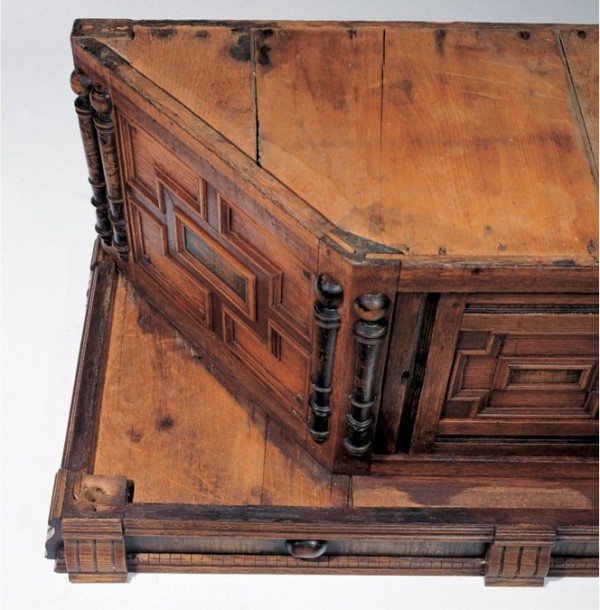
Detail of the cupboard with drawers illustrated in fig. 18, showing the underside of the trapezoidal compartment in the upper case. (Photo, Gavin Ashworth.)
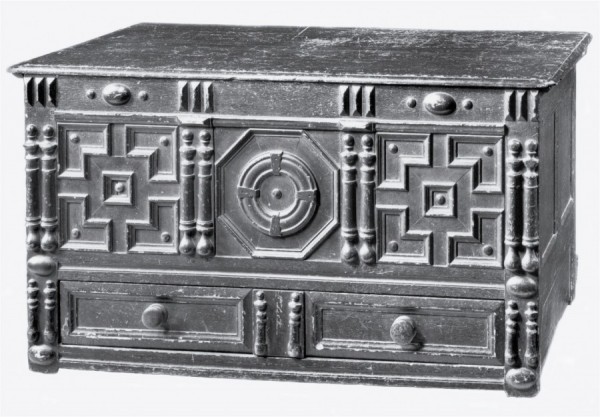
Chest, Boston, Massachusetts, 1650–1690. Red oak, black walnut, red cedar, and maple with oak and white pine. H. 26 1/8", W. 47 5/8", D. 21 1/2". (Courtesy, Historic New England; photo, Richard Cheek.) The lower drawer, framework, and feet are missing.
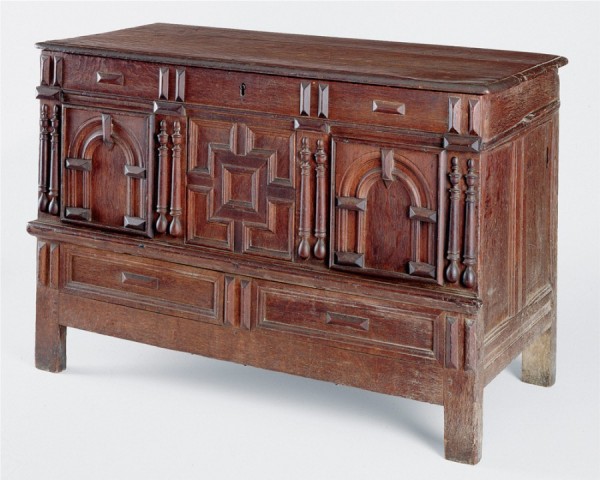
Chest, Boston, Massachusetts, 1650–1690. Oak, cedrela, and walnut with oak and white pine. H. 30 1/2", W. 45", D. 20 1/2". (Chipstone Foundation; photo, Gavin Ashworth.)
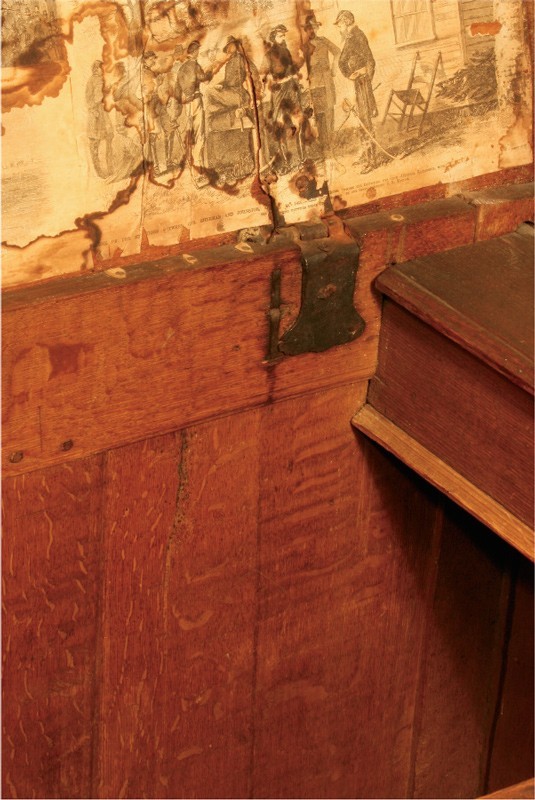
Detail of the scratch-stock molding on the interior of the chest illustrated in fig. 22. (Photo, Luke Beckerdite.)
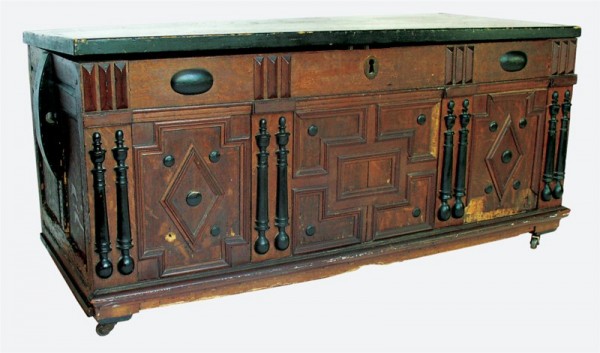
Chest, Boston, Massachusetts, 1660–1690. Oak, walnut, and maple with oak. H. 19 3/4", W. 46 1/4", D. 20". (Private collection; photo, courtesy of the owner.) The chest is missing one or two drawers below the storage compartment. The lid is replaced.
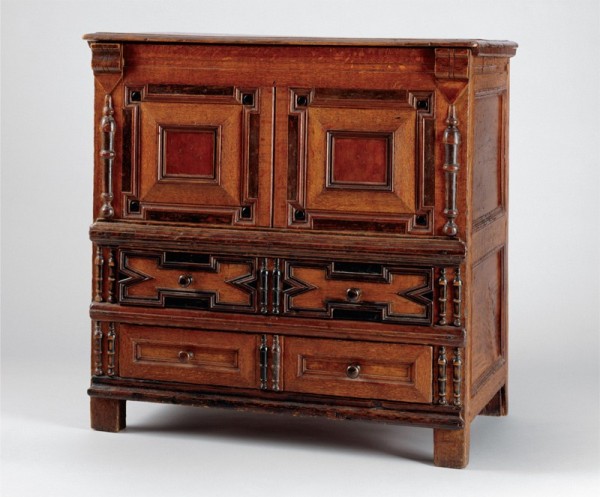
Chest, Boston, Massachusetts, 1670–1690. Red oak and black walnut with white pine and hemlock. H. 36 1/4", W. 36 1/2", D. 21 1/4". (Courtesy, Metropolitan Museum of Art, gift of Mrs. Russell Sage, 1909; photo, Gavin Ashworth/Art Resource, NY.)
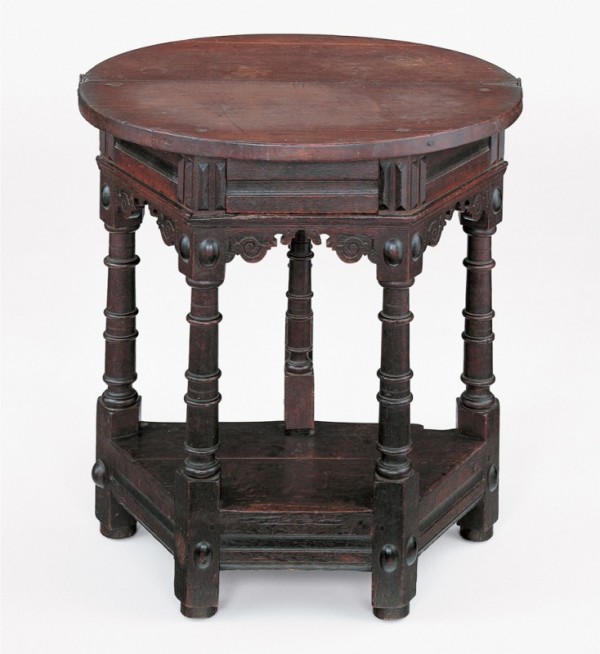
Round leaf table, Boston, Massachusetts, 1660–1690. Oak, black walnut, cedrela, and maple with oak and white pine. H. 28 3/4", W. 29", D. 29" (open). (Chipstone Foundation; photo, Gavin Ashworth.) The table is missing the molding around the lower shelf and its turned feet.
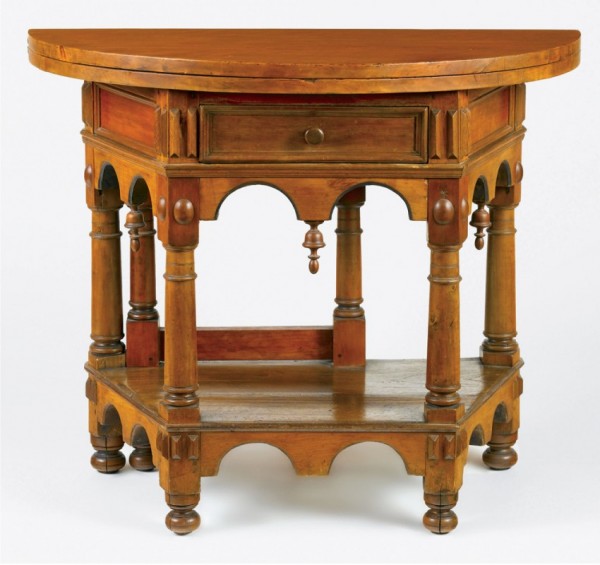
Round leaf table, Boston, Massachusetts, 1660–1690. Red cedar, cedrela and maple with oak and white pine. H. 33 1/4", W. 40 1/4", D. 20". (Private collection; photo, Gavin Ashworth.) The top, feet, fly rail, and pendants are restored.

Square table, (oak table base), Boston, Massachusettts, 1650–1680. Oak. H. 27 7/8", W. 34", D. 34 1/8". (Collection of Shelburne Museum, gift of George G. Frelinghuysen II. 1965-336.8. Photo, Gavin Ashworth.) The top and the bottom portions of the feet are missing.
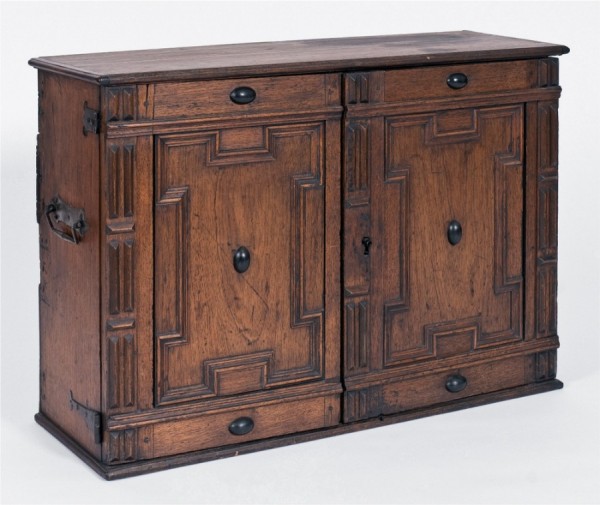
Cabinet, Boston, Massachusetts, 1650–1690. Cedrela, chestnut, oak, ash, and cedar with white pine. H. 22 3/8", W. 32 5/8", D. 11 1/2". (Courtesy, Wadsworth Atheneum, Nutting Collection; photo, Art Resource, NY.) Several moldings and interior drawers are replaced.
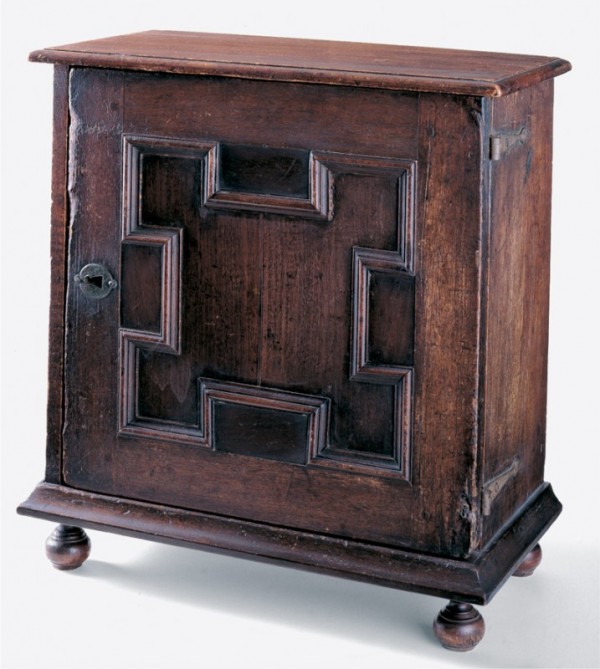
Cabinet, Boston, Massachusetts, 1660–1690. Mahogany and cedrela with oak and white pine. H. 18 5/8", W. 17 1/2", D. 9". (Chipstone Foundation; photo, Gavin Ashworth.) One foot, several moldings, the edges of the bottom board, and the hinges are restored.
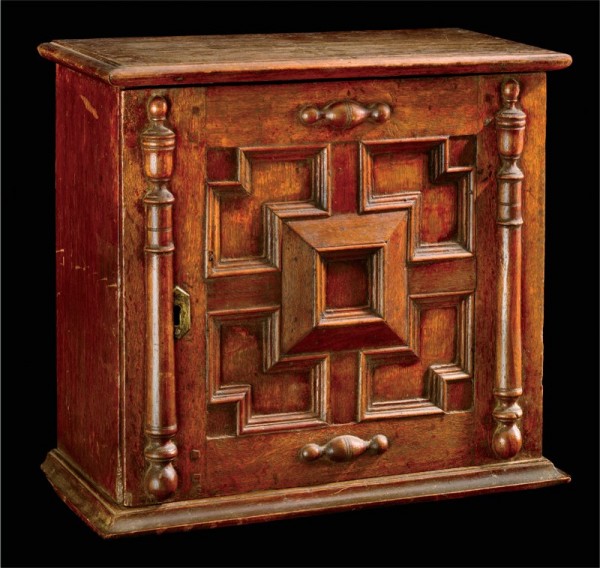
Cabinet, Boston, Massachusetts, 1660–1690. Oak, walnut, cedar, and lignum vitae with oak and white pine. H. 16 1/2", W. 16 1/2", D. 8 1/2". (Private collection; photo, Gavin Ashworth.)

Detail of the large and small applied half-columns on the chest of drawers with doors illustrated in fig. 1. (Photo, Gavin Ashworth.)
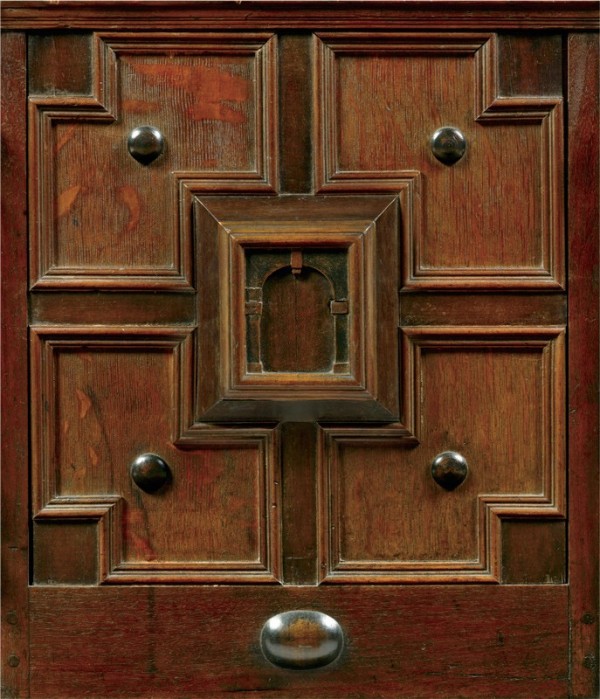
Detail of a panel on the chest of drawers with doors illustrated in fig. 1. (Photo, Gavin Ashworth.)
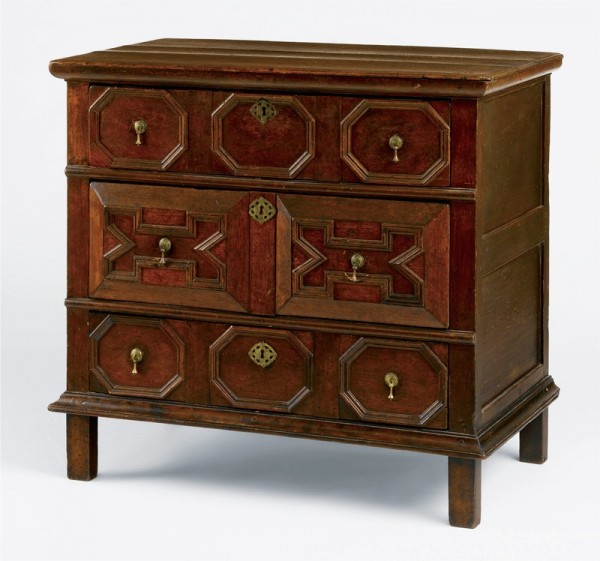
Chest of drawers, Boston, Massachusetts, 1690–1710. Cedrela with oak and white pine. H. 34", W. 33 1/8 ", D. 21 3/8". (Private collection; photo, Gavin Ashworth.)
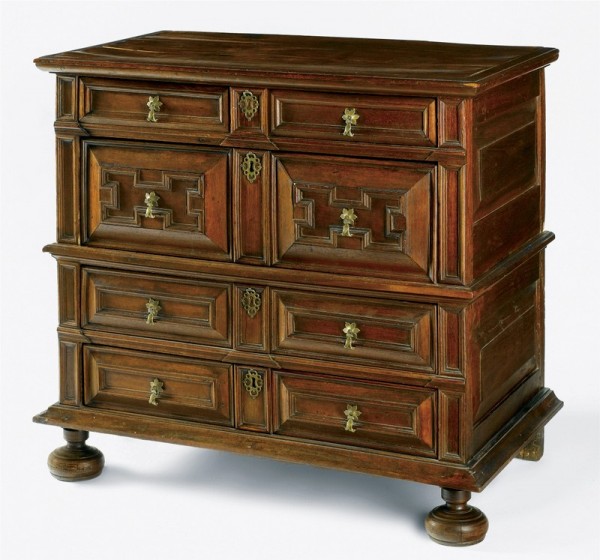
Chest of drawers, Boston, Massachusetts, 1670–1700. Walnut with oak and white pine. H. 35 3/4", W. 37 5/8", D. 21 7/8". (Private collection; photo, Gavin Ashworth.)

Detail of the chest of drawers illustrated in fig. 35, showing the hewing marks on the interior surface of a side panel of the upper case. (Photo, Luke Beckerdite.)
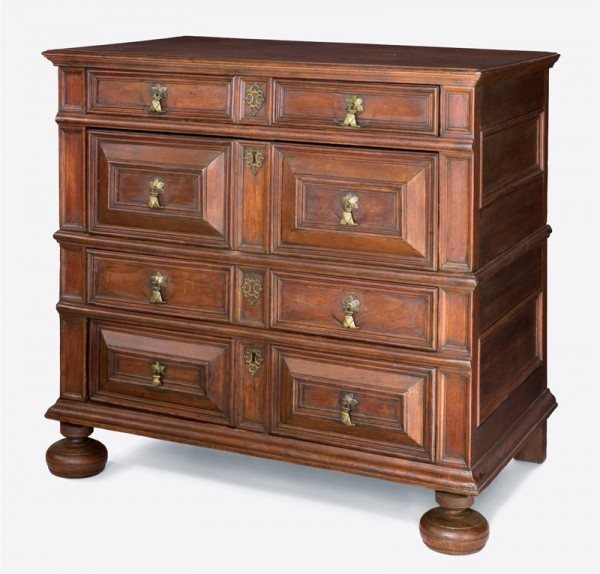
Chest of drawers, Boston, Massachusetts, 1670–1700. Walnut with oak and white pine. H. 35 3/4", W. 37 3/4", D. 23 1/8". (Private collection, photo, Mark HeVron.) This chest has all of its original hardware.
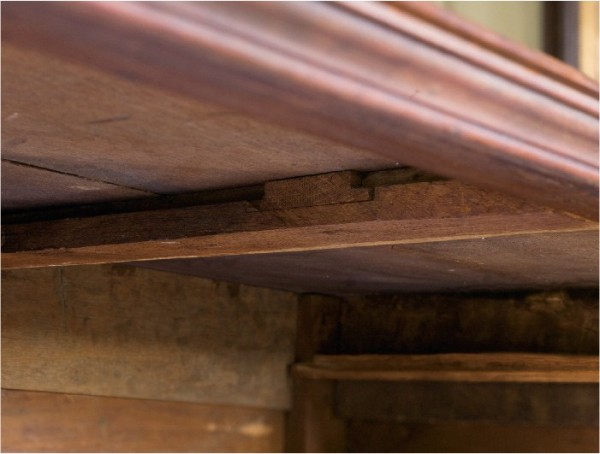
Detail of the chest of drawers illustrated in fig. 37, showing the spectral mortise on reused lumber. Reused lumber occurs on London case pieces but has not previously been recorded in Boston work.
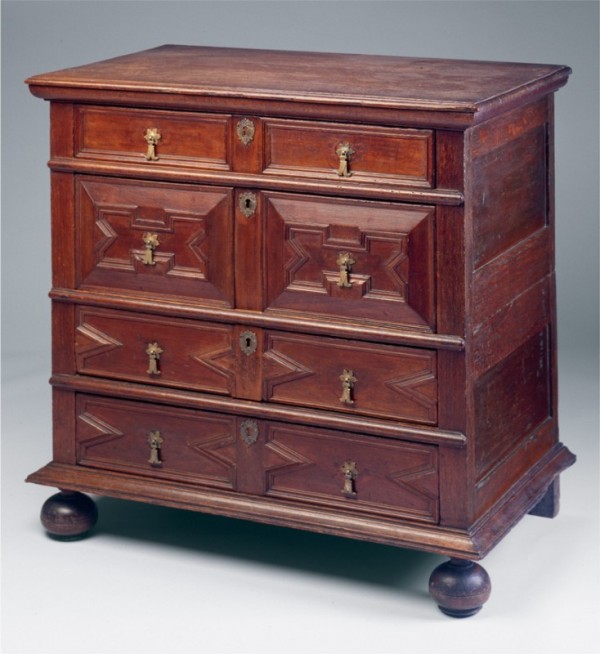
Chest of drawers, Boston, Massachusetts, 1660–1700. Oak, black walnut, red cedar, maple, and possibly cedrela, with oak, chestnut, and white pine. H. 37 7/8", W. 39 1/2", D. 23 1/2". (Courtesy, Historic New England.)
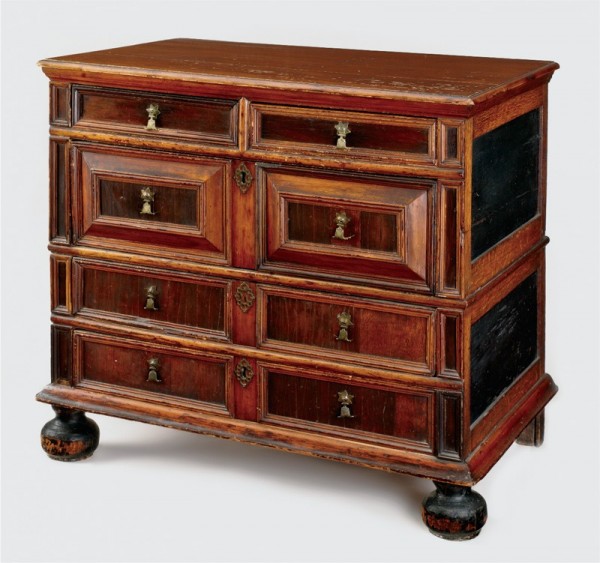
Chest of drawers, Boston, Massachusetts, 1670–1700. Red cedar and possibly rosewood with oak and pine. H. 35", W. 38 5/8", D. 23 1/4". (Private collection; photo, Gavin Ashworth.) The fronts of both case sections, the top of the upper case, and the larger and smaller moldings are made of red cedar. The chamfered edges of the cushion panel appliqués on the deep drawer are thick red cedar veneers. Because the maker intended to cover the drawer fronts completely with ornaments, he made the cores out of white pine.
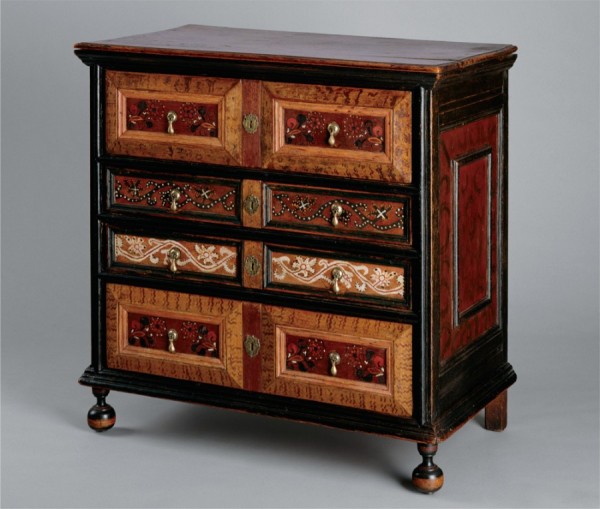
Chest of drawers, Boston, Massachusetts, 1690–1720. Red oak, white oak, white pine, and yellow pine with red oak, white oak, and white pine. H. 40", W. 40 1/2", D. 22". (Courtesy, Metropolitan Museum of Art, gift of Mrs. J. Insley Blair, 1948; photo, Gavin Ashworth/Art Resource, NY.)
